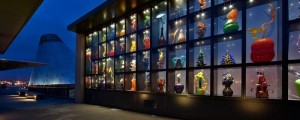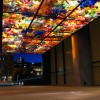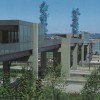- City and Installation Guide
- City Listings (new)
- Chihuly Bridge of Glass -JB Lewis McChord
Chihuly Bridge of Glass -JB Lewis McChord
Geographical Address
Business Info
- Mon Closed
- Tue Closed
- Wed 10:00 am - 5:00 pm
- Thu 10:00 am - 5:00 pm
- Fri 10:00 am - 5:00 pm Closed now
- Sat 10:00 am - 5:00 pm
- Sun 10:00 am - 5:00 pm
The Chihuly Bridge of Glass is Tacoma's stunning link to the Thea Foss Waterway and the Museum of Glass. The 500-foot pedestrian bridge holds three amazing Chihuly glass installations, open to the public 24 hours a day. Linger at sunset on a date, and you'll see why it's one of the most romantic places in Washington.
Getting there: From Pacific Avenue, you'll cross under the arches of the Washington State History Museum and arrive at the first glass installation, the Seaform Pavilion. The pavilion ceiling was created with over two thousand glass objects, and you will feel like you are underwater at a great coral reef of beautiful glass shapes. The crystal towers at the center of the bridge capture daylight and shine as if they have a light of their own. The blue translucent crystals call to mind images of cool blue glacial ice and change their appearance at different times throughout the day. At night, they are illuminated from below and add to the night skyline. Venetian Wall 109 Chihuly sculptures fill the eighty-foot-long wall (pictured above, with the Museum of Glass Cone behind). With a variety of sculptures throughout, including some of the largest ever blown, you will emerge from the Bridge with a new appreciation of glass art.
The bridge is the gateway that welcomes people to Tacoma. We wanted something unique in the world, something that is full of color and offers a joyous experience to passersby both night and day. —Dale Chihuly
Map
-
{{#owner}}
-
{{#url}}
{{#avatarSrc}}
{{/avatarSrc}} {{^avatarSrc}} {{& avatar}} {{/avatarSrc}} {{name}} {{/url}} {{^url}} {{#avatar}} {{& avatar}} {{/avatar}} {{name}} {{/url}}
- {{/owner}} {{#created}}
- {{created}} {{/created}}




